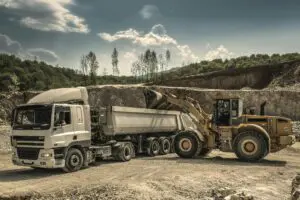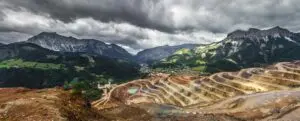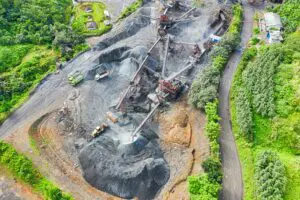With China dominant in the mining and processing of rare earths, the West faces a daunting task to build supply chains of the critical minerals independent of the Asian superpower. The Northern Miner wanted to find out how the countries of the Americas are faring in exploring and developing the 17 rare metals vital in the manufacturing of cellular phones, computers and magnets for green energy technologies and electric vehicles.
To help paint a clearer picture of the activity, we turned to our data provider Mining Intelligence (MI).
According to the MI database, there are 132 rare earth projects in North and South America, ranging from prospecting to production.
Of the total, 37 projects are in the advanced exploration to production stages. The majority of the projects (51%) are in exploration. Only 18% have some level of economic study or are in permitting, construction or production.
Data from Mining Intelligence. Credit: The Northern Miner/Canva
Data from Mining Intelligence. Credit: The Northern Miner/Canva
Which rare earths are being explored and mined?
Although rare earth projects often contain many of the 17 elements, not all are economically recoverable. Among the 37 projects in the advanced exploration to production stages, neodymium and praseodymium — widely used in permanent magnets for motors — represent about 50% of the sought-after elements. Lanthanum, used as an alloy with nickel and in hybrid cars makes up about 10% of the target minerals.
Data from Mining Intelligence. Credit: The Northern Miner/Canva
Where are the projects?
Geographically, “rare” describes the elements and the mining activity because exploration and development is occurring in only seven countries, including Canada.
More than two-thirds of all rare earth activity in the Americas (91 projects) is in Canada, with more than half at the exploration stage. Eight have PEAs, six are in advanced exploration, and two each are in prefeasibility and feasibility stages. Only one is classified as producing.
As it does with lithium, Quebec hosts the majority of rare earths projects in the country, with 35, most of which are in exploration.
Ontario and Newfoundland have the second and third highest number of projects.
Though the N.W.T. has only two projects, it also hosts the country’s most advanced rare earths project: Vital Metals’ (ASX: VML; US-OTC: VTMXF) Nechalacho project 110 km southeast of Yellowknife. In April 2022, Vital started shipping rare earth oxides mined at the demonstration-scale project to a processing facility in Saskatoon, but Vital paused the shipping of rare earths in April this year after determining the project wasn’t economic.
After Canada, the United States hosts the most rare earths projects at 24, mostly in the west and southwest, with a few in southern states such as Arkansas and Tennessee.
Map showing the number of advanced projects in provinces, territories and states of North America. Credit: The Northern Miner
Data from Mining Intelligence. Credit: The Northern Miner/Canva
California is home to the Americas’ only producing rare earths mine: MP Materials’ (NYSE: MP) Mountain Pass mine in California, just west of the border with Nevada. Molybdenum Corporation of America began mining rare earths at the site in 1952. MP Materials revived the project and began selling rare concentrate in 2018. The facility mines bastnaesite ore which is eventually separated into lanthanum, cerium and neodymium and praseodymium oxide. In February, MP made a deal with Sumitomo Corp. to supply the Japanese company with rare earths smelted and separated at its California facility, bypassing China. MP had previously shipped its output to China for processing, with Japanese companies buy it from there.
South of the U.S., Brazil hosts the most projects, with 11. The most advanced project in the country and in South America is held by Serra Verde. The company, which is controlled by global investment firm Denham Capital, plans to start commercial production at its Pela Ema deposit in Goias state by the end of the year. It will produce heavy and light magnetic rare earths including neodymium, praseodymium, terbium and dysprosium.
Chile has three projects at different stages. Aclara Resources’ (TSX: ARA) Penco Module is the most advanced, after it released a PEA in 2021. In June, Aclara said it had produced its first sample of concentrated high purity heavy rare earth elements following a commissioning period using ionic clays. Aclara expects to publish a feasibility study for Penco in the third quarter. However, the company hit a roadblock in early July when the Chilean government’s environmental agency halted a review of Aclara’s environmental impact assessment application due to the presence of a vulnerable tree species on the project site, near Concepcion
Mexico, Colombia and Peru each have one exploration stage project.
Who owns the projects?
The ownership of rare earths projects in the Americas mirrors their location, with almost two-thirds (64%) of the projects held by Canadian companies. Projects owned by American and Australian companies are at 14% and 13%, respectively. The rest of the projects are owned by companies headquartered in Brazil, Chile and Japan.
Data from Mining Intelligence. Credit: The Northern Miner/Canva
Of the projects in stages from “advanced exploration” to PEA to production, Australian, Canadian and U.S.-based companies each hold four projects. Brazil holds one.
Six of the 13 projects are in the U.S. and five are in Canada. Other than Serra Verde’s Pela Ema project, the other advanced project in Brazil is the prefeasibility-stage Araxa project in Minas Gerais state, held by Delaware-based Itafos (TSXV: IFOX).



























